#stromatolite fossil
Text

Stromatolite Fossil
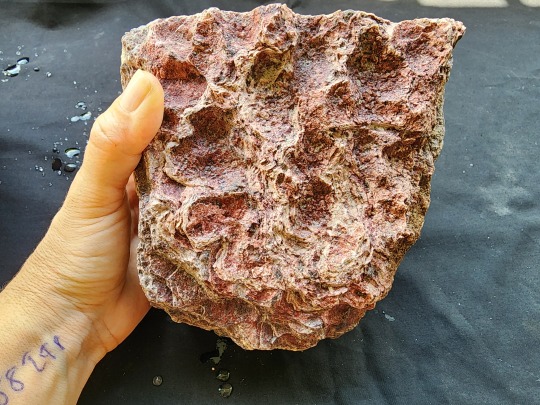

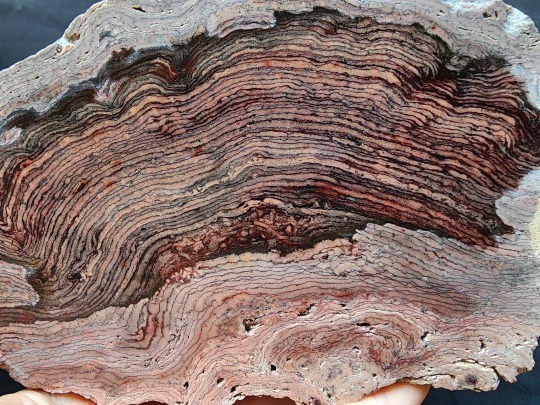
When I first saw this stone, I was excited. I was even more excited when I found out what it was. A record of the first life forms on Earth. Information from billions of years ago. How could I not be excited?
I would love to know all the information hidden inside this beautiful fossil.
Stromatolite Fossil
#fossil#fossils#paleontology#paleoart#special collections#stone aesthetic#collectibles#geology#geological formations#paleontography#stromatolite fossil#microbiology#rock collection#rocks and minerals#the collector
673 notes
·
View notes
Photo

An example of stromatolite, a layered sedimentary formation caused by photosynthetic bacteria. This example is around 2.2 billion years old.
by Bernard Dupont
5K notes
·
View notes
Text

A stromatolite. They're formed by layers of microbes living and dying on top of one another and are some of the oldest fossils on Earth.
10 notes
·
View notes
Photo
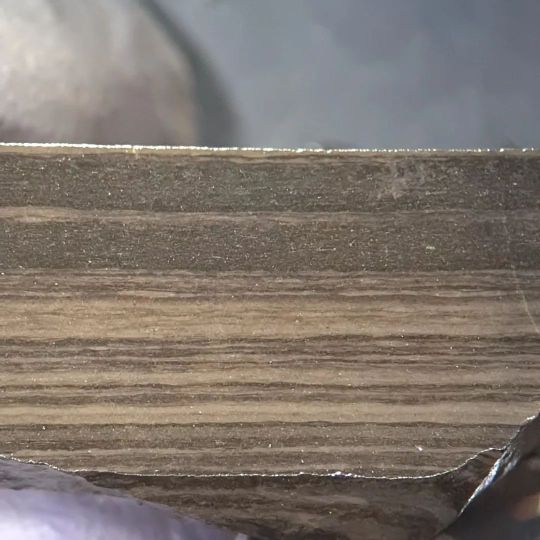
This sample consists of black wrinkly microbial mats, and green grey claystone from the 1.4 billion year old Velkerri formation, from northern Australia. The mats were dominated by cyanobacteria living on the bed of a shallow sea that covered northern Australia at the time. The organic matter contained lots of sulphur which was converted into pyrite during burial. You can sea the pyrite as the sparkly gold flecks in the close up of the black mats. This area of the sea was far from land so instead of depositing grains eroded from existing rocks, like sand, sediment chemically precipitated from the sea water. The sea was rich in iron and silica and so iron silicate clays formed on the sea bed. The iron is green because they're was little oxygen around for it to react with. This process of chemical sedimentation is very slow and so there was plenty of time for the mats to grow across the sea bed. This also means that other material can accumulate on the sediment that would be lost in areas of rapid sedimentation. So I've also found lots of volcanic ash and spherules in these layers. I've also found mysterious grains in these samples which may be impact spherules from a meteor impact, or perhaps even micrometeors too. We don't know what the banding represents. It could be seasonal growth of the mats, it could reflect how nutrient abundance changes, or could effect changes in the rate if sedimentation. It could even reflect all our none of the above. I'm going through these samples, documenting the sedimentary textures and deciding which samples I want to turn into thin sections to examine under the petro microscope, and then to digest in acid to extract the fossils from. #geologyjohnson #geologist #geology #geologyrocks #sedimentary #microbial #microbialmat #precambrian #mesoproterozoic #fossil #fossils #stromatolite #Australia #green #shale #mudstone #earlylife #proterozoic https://www.instagram.com/p/Cc-dI2mNRVF/?igshid=NGJjMDIxMWI=
#geologyjohnson#geologist#geology#geologyrocks#sedimentary#microbial#microbialmat#precambrian#mesoproterozoic#fossil#fossils#stromatolite#australia#green#shale#mudstone#earlylife#proterozoic
12 notes
·
View notes
Text
NASA Rover Reaches Promising Place to Search for Fossilised Life on Mars
Unlike its predecessor Curiosity, NASA’s Perseverance rover is explicitly intended to “search for potential evidence of past life,” according to the official mission objectives.
The Best Things You Didn’t Know Your Switch Could Do
Jezero Crater was chosen as the landing site largely because it contains the remnants of ancient muds and other sediments deposited where a river discharged into a…
View On WordPress
#Astrobiology#Composition of Mars#Creative Commons#Environment#Fossil#Gizmodo#Jet Propulsion Laboratory#Jezero#Jezero crater#Ken Farley#Life on Mars#limestone#mars#perseverance#Sample-return mission#Sean McMahon#Sedimentary rock#Stromatolite
0 notes
Text
A fun story about a stromatolite.
A stromatolite, or stromatoliths, are layered sedimentary formations that are created mainly by photosynthetic microorganisms such as Cyanobacteria, sulfate-reducing bacteria, and pseudomonadota. These microorganisms produce adhesive compounds that cement sand and other rock materials to form mineral “Microbial Mats”. In turn, these mats build up, layer by layer, growing gradually over time.
In nature, these living micro organic rocks pail in comparison to how large the fossilized predecessors grew. They are some of the oldest fossils on this planet. Current living species of stromatolite grow anywhere between 1 foot and 3 feet. The fossilized specimens have been found to be up to 20 feet tall.
Doctor Fondy Mescaf has studied these fossilized creature rock making machines and made a break through in the lineage of its current existence.
Doctor Mescaf started the initial DNA altering, with the assistance of two T.A.’s and in front of a class of Under grad Students, with a process that cross referenced sequencing from the fossilized artifacts and the modern day living ones we have. The ancestors DNA was found to be significantly smaller. The sequence was easily duplicated by chopping a section of the dna down to a point that looked closest to its earlier ancestors length. It was at times a guess, a shot in the dark, a Hail Mary if you will; but it led to the discovery that would not only change who we are as humans, but change how we think, feel, and interact with the universe around us.
In nature, as it was 3 Billion years ago, where this particular early ancestors DNA would have existed, it would have lived for decades, centuries, and in some isolated fossilized cases, millennia. The sample DNA was one of those isolated cases. This ancestral form was perfectly suited for survival in small but powerful numbers. It was designed to survive being buried under ever shifting sand dunes that were at the bottom of the sea. Only being exposed for a couple of days at a time, it would get all the nutrients it would need before being buried again for months. They had evolved to survive a life of entombment with far and few days of exposure to feed.
However, when grown in lab conditions, with all it can ever eat and need to reproduce, it took full advantage of all its available resources.
Let me introduce you to Bach aka Stromatolite 4367. Bach chose their own name during observation day 4,367. Day 1 was the aforementioned DNA experiment that brought back a centuries old being with the flick of a blade. A simpler DNA that was able to unlock connections to the world that none of us could have imagined, and had always been alive, on our planet, just in the background. Growing with humanity, being the origin of a once thought to be nonexistent form of communication to all beings.
We do need to admit this was a reckless butchering of a living organism that could have led to a veracious form of hostile DNA that could have microscopically infected all of humanity and earth in the blink of an eye, but instead led to the day we celebrate as The Day Of First Contact with another intelligent species, and they have named themselves Bach.
And I know you’re asking yourself if it is after that Bach. Yes. It is named after That Bach. They named themselves, their existence, the pure and unaltered DNA of stromatolite 4367 on day 4,367 named themselves after the late baroque period classical composer and musician Johann Sebastian Bach because, in that time, they had learned enough about our society and our people, and our world that Bach was the most inspiring to them and they felt the classical emotion humans get when they listen to Bach and think about the baroque period was the same emotion they wanted to give the humans when they joined as one.
Day 4,367.
#stromatolites#lite stromatolite humor#you should seriously consider joining though#Bach is so nice#they take me on a date every Wednesday#I always look forward to it#they could treat you nice too#it’s not like you want to be alone forever#they want to love you#and take care of you#writers on tumblr#write a day#the story within#fossils#stromatoliths#just let Bach in#I promise this is not an MLM
0 notes
Text
Morocco 2023: The Trilobite's Sahara Kingdom
November 2023 saw the eighth running of GeoWorld Travel’s “The Trilobite’s Sahara Kingdom” trip to Morocco. We were delighted to welcome guests from the UK, the USA, Germany, Greece and the Netherlands on our latest geological adventure. We followed the same route as in previous years, journeying from Marrakesh, across the High Atlas via Zagora to Merzouga, before returning via the Todra Gorge to…
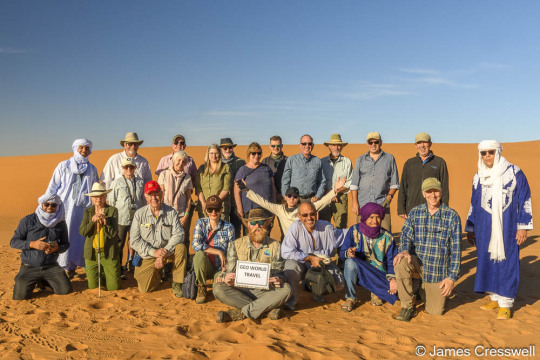
View On WordPress
#desert#fossil#fossil adventure#Fossils#geology#geology holiday#geology tour#geotour#geotourism#lagerstatte#marrakech#minerals#Morocco#sand dunes#stromatolites#trilobite#trilobites#World Heritage Site
0 notes
Text
Crystals will not cure your cancer, but as an animist I do feel like there are vibes. Perhaps not a mind, but vibes
#ect#this is just how I feel the world okay?#I’m not looking to debate. just share my perspective#although animal fossils can be different#they have a memory to them. almost like a grave#and sometimes you can still interact with the spirit#other times they tell you to fuck off and op#and let them chill. none that I’ve encountered cared much about the fossil itself being held#but they didn’t want any contact in the sense that you get when talking to their spirit#they have been used to the stone itself doing whatever#but don’t want to chitchat#they’ve been taking a million year dirt nap so to speak. so why would they want to talk to some human#some do like the fresh company#although many don’t have much connection to the body that made the impression at all#it’s just a memory of a creature that has completely moved on#with little connection to the now living#especially very veeerrrry old fossils#especially very old fossils of living organisms that had no brain#stromatolites only give the impression of something being alive#and not much more than that#at least to me
0 notes
Text
Spectember D29: Speculative Biome

Is not an oddity for geologists to look at some strange landscape formations, many caused by singular events or just by erosion, but the most particularly perplexing ones have been made by what is not considered to be a thing from this world...
North America seems to be dotted with dozens of these structures and the remains of already fallen ones, looking like gigantic towers of more than a kilometer in height, structured like a strange tree shaped form, it rises like a testament of the biggest terrestrial organism known, a monster tree made of stone and shaped by the millions of years of constant growth by part of a singular organism.
In Wyoming there is the most intact and oldest specimen of such beings, bein nicknamed Heaven’s Tower, unique megaorganisms formed by thousands of individual slime like organisms that behave like a stromatolite as it accumulate over layers over layers of sediment and material it built its structure, the way it do it seems to comprehend a system of vessels that transport the material from the terrain, often hollowing the terrain below forming a large cave chamber system that accumulate water and organic matter, preserve itself from erosion protected by a microbial layer product of the same organism. The tower seems to often renovate itself by the use of a special slime covering every century based on studies of change of texture and viscosity in the tower surface, but from what accounts on different expeditions into the inner cave system denote that the whole Tower formed dozens of millions of years ago, from mining expeditions around the chamber as well drilling in the main structure it was found it preserved a decent amount of data in the form of layers created by the accumulation of minerals by the slime into the main structure like a terrestrial stromatolite, this giving a possible date of the formation of the original tree around the late Eocene or early Oligocene.
As well seems to be every 5 to 10 million years there is a process that allow the introduction of surface fauna that always ends up into the lower chamber, to be eventually isolated which seems to last for few million years until there is a occurring a total extinction of the inner fauna, caused by the replacement and collapse of a old layer as its being replaced by a new one of almost 20 m of thickness, so far from fossil record the last breach occurred around the late Pliocene, isolating the fauna that lived upon that time.
The way one of the Heaven’s Tower specimen grow or originate is pretty much unknown for the very long span of time it takes to even start forming, is believe one of these might find a specific and rich place to feed its structure, more or less an old volcanic region and slowly accumulate to form the megastructure that feed symbiotically by chemosynthesis from the igneous rocks and photosynthesis, as well there has been identified fossil remains of older already fallen Towers that also expose similar patterns of growing. The Heaven’s Tower of Wyoming is the last intact structure as many seems to have been destroyed by the last ice age, and will take millions of years to recover, this itself is a testament of a paradoxical being that is still investigated, as this being for many accounts seems to not share any significant relationship of any living organisms.
276 notes
·
View notes
Text

The Paleoarchean era lasted from 3.6 to 3.2 billion years ago. As the sea levels rose and the crust continued to cool, the Earth's first major landmass would form. Today we call it Vaalbara. We don't know what this landmass would have looked like but we do know it was at least made up of southern Africa and western Australia.
Though life may have begun a few million years earlier, from this period we have the earliest evidence of life in the form of stromatolites. Fossilized mats of microbial organisms forming bizarre rock-like structures that can be found today near the remnants of Vaalbara.
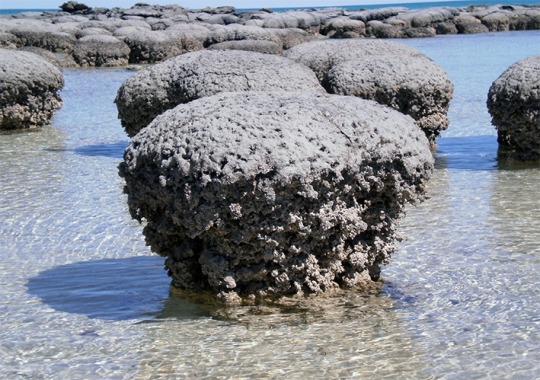
#Paleoarchean#journey through time#Precambrian#archean#Vaalbara#stromatolites#paleoart#paleontology#evolution
18 notes
·
View notes
Text
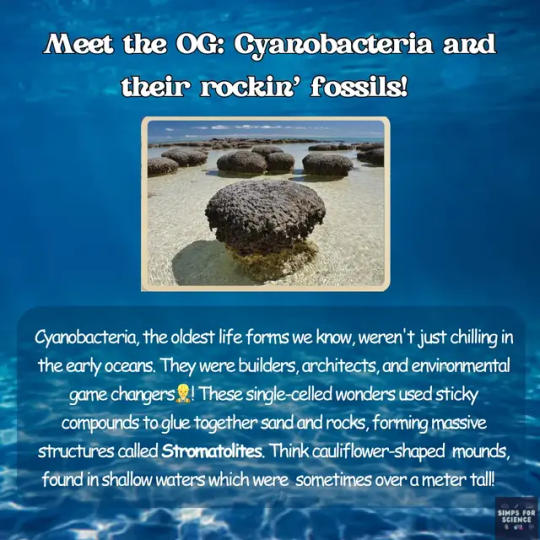


Being the most ancient⌛fossils, stromatolites stand as resilient monuments to Earth's 🌍infancy. Delve into the story📖 etched by them through this post. To dive deeper into the history of our planet, join us in our monthly series - 'Zoofabulous Time trek'.🏎️ Hold your breath, because we're about to dive deep into the past!
📸Image Credit: Wikipedia
#education#science#science facts#study blog#research scientist#discover#earth#zoology#animals#wildlife#fauna#cyanobacteria#fossils#ocean life#sea#scicomm#ediacaran#microbiology#australia#microbes#explore#paleontology#nature#archaeology#history#precambrian#planets#seashore#geology#prehistoric
17 notes
·
View notes
Photo
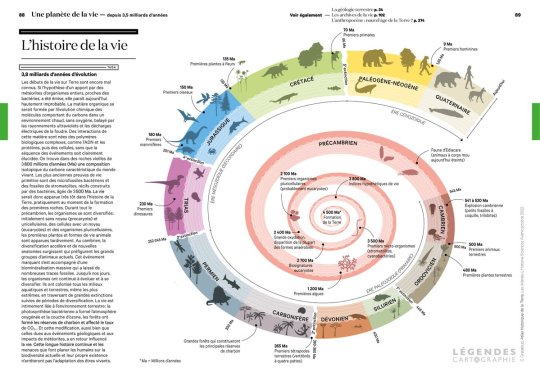
The history of life on Earth: 3.8 billion years of evolution.
by @LegendesCarto
The beginnings of life on Earth are still poorly understood. If the hypothesis of a contribution by meteorites of whole organisms, close to bacteria, has been put forward, it now seems highly improbable. Organic matter would have been formed by the chemical evolution of molecules containing carbon in a hot environment, without oxygen, swept by ultraviolet radiation and electrical discharges from lightning. Interactions of this material have arisen from complex biological polymers, such as DNA and proteins, then from cells, without the sequence of events being clearly elucidated. One finds in old rocks of 3800 million years (Ma) an isotopic composition of carbon characteristic of the living world. The oldest evidence of primitive life are bacterial microfossils and fossils of stromatolites, reefs built by bacteria, 3500 Ma old. Life would therefore have appeared very early in the history of the Earth, almost at the time of the formation of first rocks.
Throughout the Precambrian, organisms diversified: initially without a nucleus (prokaryote) and unicellular, cells with a nucleus (eukaryote) and multicellular organisms, the first plant and animal life forms appeared late. In the Cambrian, diversification accelerated and new anatomy emerged that prefigured the large groups of animals today. This milestone event was accompanied by massive biomineralization that left numerous fossil traces. Until today, organizations have continued to evolve and diversify. They have colonized all aquatic and terrestrial environments, even the most extreme, going through great extinctions followed by periods of diversification. Life is intimately linked to the terrestrial environment: bacterial photosynthesis has formed the oxygenated atmosphere and the ozone layer, forests have formed carbon reserves and affected CO2 levels. And this modification, as well as those due to geological events and meteorite impacts, has in turn influenced life. This long history continues and the threats that humans pose to the current biodiversity and their own existence will not stop the adaptation of living beings.
153 notes
·
View notes
Text
Happy New Year!
Let's imagine it was the Earth itself that was going into its 2024th year. That is to say, we're compressing the entire history of the Earth into just the past 2023 years. What events would have happened when?
Well, not too much is certain about the first couple decades after our planet formed, until around 50 CE when we were hit by another proto-planet, Theia, and the debris formed the Moon. After a couple years of the planet cooling down again, the oceans formed out of boiling rain. The timing of the origin of life is very uncertain, but there are chemical signs it may very well have happened as early as the second century. Around 200 CE, the gas giants did a big funky orbit-swapping dance, and in the process inflicted the Late Heavy Bombardment on the rest of the solar system, meaning the Earth was suffering a ton of meteorite strikes for the entire third century.
The first indisputable evidence of life is from around 330, and the first stromatolites appear around 470. Those are basically the first fossils, stones created by layer upon layer of oxygen-producing cyanobacteria living and dying on top of one another. But even with oxygen producers evolving, it would take many centuries before oxygen became a major part of the atmosphere: not until the Great Oxygenation Event, which happened during the ninth and tenth centuries. That's also about the time the first complex, eukaryotic cells evolved through a symbiosis between an anaerobic archaean and an oxygen-breathing bacterium. The bacterium became more and more focused on just the oxygen-breathing task inside the larger cell, until its descendants were mitochondria, which as you all know are the powerhouse of the cell. The next seven centuries passed by with only slow, gradual changes, and life continuing to be unicellular and difficult to find in the fossil record.

(1735's Snowball Earth, by me)
From 1704 to 1730, the entire planet froze over. After merely two years of thaw, it happened again, this time lasting from 1732 to 1742. But these snowball Earth episodes set the stage for the evolution of animals that began right after. Across the mid-18th century, the bizarre Ediacaran biota, with its strange symmetries, fronds, and fractal-like pattern filled the oceans. In the early 1780s they went extinct, possibly due to a temporary drop in oxygen-levels, only to be replaced by a great variety of quite different creatures in the Cambrian Explosion.
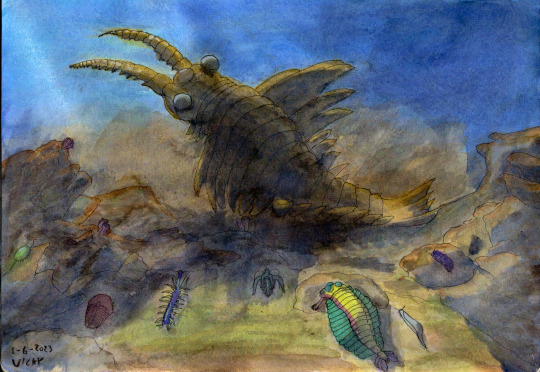
(Class of 1799, by me)
Starting in 1784 and running for a few decades, the Cambrian period saw the origin of most of the modern animal phyla, reaching its most famous form in the Burgess Shale fauna of 1799. During this time, most animals still lived on the sea floor, either attached or crawling, with relatively few actually swimming creatures. Plants started tentatively moving onto land around 1817, and in 1825, the rising of the great Appalachian mountains caused a severe drop in global CO2 and thus temperatures, leading to the Late Ordovician mass extinction.

(Horseshoe crabs and sea scorpions on a beach in 1834, by me)
Bony fish first showed up during the 1830s, and around the same time plants were getting serious about inhabiting the land, evolving roots and vascular tissues so they could properly grow there. Millipedes and the ancestors of spiders were the first animals to follow them onto land. Our own fishy ancestors did not take their first step until 1857, by which point the arthropods were well established there and the plants had figured out how to become trees. The Late Devonian extinction, partially caused by the evolution of said trees and partially by the south pole freezing, played out in two pulses over the late 1850s and early 1860s.
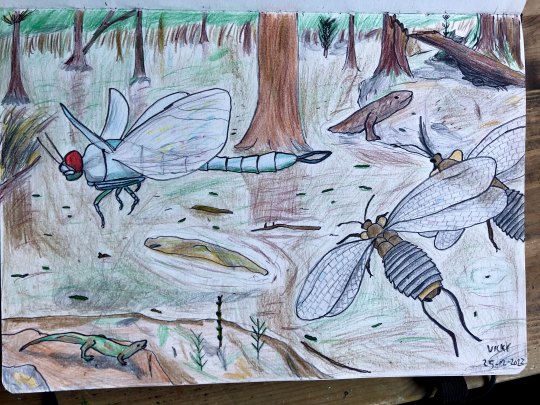
(Swamp prominently featuring Meganeura and Mazothairos in 1889, by me)
Arthropods and vertebrates continued to gain adaptations to life on land. The insects became the first creatures ever to fly in 1878, and the high-oxygen atmosphere of the time would be especially good to them. Around 1884, a group of vertebrates called the amniotes, after the membrane that kept water inside their eggs so they could lay them on land without them drying out, split into two groups: the reptiles and the synapsids (which we mammals descend from). The next few decades would see the synapsids in particular being extremely successful as the supercontinent Pangaea formed. Until 1912, when a massive episode of volcanism caused the worst mass extinction of all time, the Great Dying, scouring the Earth of a huge portion of its life.
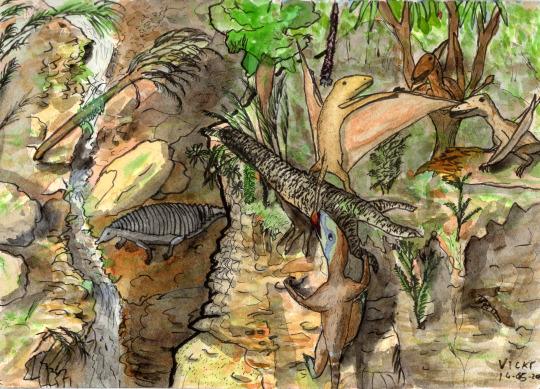
(A 1930 scene featuring the three branches of archosaur: dinosaur, pterosaur, and pseudosuchian, by me)
The 1910s were a period of slow recovery during which strange new forms of animal evolved. Many different, unrelated reptiles, such as the ichtyosaurs and plesiosaurs, went to sea, where they would continue to provide some of the most impressive creatures for most of the 20th century. On land, the dinosaurs first appeared in 1920, though for the next decade or so they'd live in the shadow of their pseudosuchian (crocodile-line) cousins. In 1934, Pangaea began to break up, resulting in another terrible pulse of volcanism that caused a lot of extinctions and left particularly the feathered and furry survivors with a lot of empty niches to fill, allowing the dinosaurs and mammals to diversify greatly. The last common ancestor of all modern mammals lived in the early 1940s, and by 1957 the dinosaurs had figured out flight, with Archaeopteryx usually being considered the first bird. Other dinosaurs took on an incredible variety of sizes, shapes, and forms. Some of the most famous ones include Dilophosaurus (1942), Diplodocus and Stegosaurus (1955), Iguanodon (1969), Velociraptor (1991), and Tyrannosaurus rex (1994).

(A tropical lakeside in the year 2000, by me)
In 1995, the world was struck by a meteorite, wiping out many groups, including the marine reptiles, pterosaurs, and ammonites. The surviving mammals and dinosaurs went on to diversify across the next couple of years and had formed thriving new ecosystems in the tropical world of the turn of the millennium. The first known bat lived in 2001, and the whales returned to the oceans next year. Around 2009, the world's climates turned colder and dryer. Antarctica froze over and grasslands spread widely. Our last common ancestor with the chimpanzees and bonobos lived in 2021, and by new year 2023, our ancestors were getting brainier and more proficient with tools. That's also when the north pole froze and the Quaternary ice age cycle began. The first known members of Homo sapiens lived on 10 November 2023. The latest ice age started on 14 December, and ended at 2 AM on 30 December. The great pyramid of Giza was built at 6 AM on 31 December and On The Origin Of Species was published at 23:22 PM.
#palaeoblr#happy new year#2024#geologic timescale#vicky's vritings#one year is 2.244 million years if you're curious#and yes i did exclude both year 0 and 2024#since 0 doesn't exist and 2024 hasn't happened yet#my art#i rather enjoy having an extensive collection of my art to illustrate my paleorambles nowadays#incidentally the big bang occurred in 4121 bce at this scale#which is curiously close to the date of creation creationists made up#if only they would follow through and insist humanity itself was seven weeks old too
124 notes
·
View notes
Text
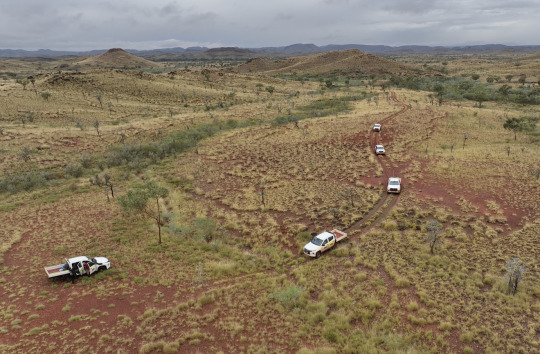

NASA, Partners Study Ancient Life in Australia to Inform Mars Search
NASA is working with its international partners to study the ancient Earth as it relates to Mars.
In June 2023, NASA's Mars Exploration Program leaders joined their counterparts from the Australian Space Agency, ESA (European Space Agency), and the Australian Commonwealth Scientific and Industrial Research Organization (CSIRO) on a field expedition to visit some of the oldest convincing evidence of life on Earth.
"This science expedition was a great opportunity for NASA to work with our international partners to study the ancient Earth as it relates to Mars, which may have had a similar past," said Eric Ianson, director of NASA's Mars Exploration Program at NASA Headquarters in Washington. “The more we learn about our planet's evolution, the more we can apply that knowledge to our characterization of the Red Planet.”
The Pilbara in the Western Australian Outback is one of the few places in the world to hold an ancient geological record of our ancient planet. As the international community continues working together to study Mars and prepare for samples to bring to Earth, these teams explored what our own backyard can teach us about the search for life elsewhere.
"What we're looking at here in Western Australia are known as stromatolites," said Mitch Schulte, program scientist for the Mars Perseverance Rover at NASA Headquarters. "They're fossils caused by mats of microorganisms living around 3.5 billion years ago that had their presence captured and preserved in the rock record for all this time."
Due to the geological processes that continually reshape and recycle the Earth’s surface, it is extremely difficult for stromatolites or other fossils to be preserved on Earth for long periods of time, so only a fraction of past life remains in the geological record. In the Pilbara region, the rock record was able to stay intact over billions of years, resulting in outcrops of geology that match the same age as we see on much of the surface of Mars. This makes the location a critical testing ground for scientists and engineers to hone their skills for identifying signs of life in ancient environments.
The international delegation spent the week-long expedition to the Pilbara considering the difficulties of locating fossil evidence and how our missions are using techniques, including making detailed contextual measurements, to overcome such challenges. Discussions centered on how challenging it is to find and confirm signs of past life in ancient rocks, even on a planet like Earth, where life is known to have gained a foothold.
"To be able to prove that a feature is biogenic, not only do you need to be able to prove that life can create it, but you also need to be able to prove that the particular version of the feature was not created by something else," says Lindsay Hays, deputy lead scientist for Mars Sample Return and Program Scientist for Astrobiology at NASA Headquarters. "You have to understand what else is going on in the historical record of the rock section to be able to understand what you're looking at."
A central theme of the field workshop was the importance of geological context when choosing sampling sites and eventually confirming the integrity of a sample's biological origin. The Pilbara is the perfect classroom for teams to study stromatolites that have withstood the test of time and scientific rigor and understand what they might be looking for on Mars. The group investigated how the environment in which these signs of ancient life were found could have been conducive or unfavorable to biology taking shape.
NASA’s Perseverance Mars rover has been traversing Jezero Crater, which contains an ancient river delta, since Feb. 18, 2021, caching samples of rock and regolith that may contain signs of ancient microbial life from this same period of 3 to 3.5 billion years old. The exercises on this expedition mimicked what Perseverance is doing remotely, millions of miles away: identifying samples in the field and studying the area around them. As we look to the next phase of the rover's sampling campaign, the international community can use the information we've learned about the importance of environmental context on Earth to make sure that the most scientifically viable samples are being collected in tandem with the appropriate context to make the measurements that will address our biggest scientific questions about Mars upon their arrival on Earth.
This astrobiology expedition sets the stage for continued investigation and collaboration as NASA's Perseverance rover, ESA's ExoMars program, and the two agencies’ joint Mars Sample Return missions will work together to try to answer humanity's age-old question: are we alone?
TOP IMAGE....Members of NASA's Mars Exploration Program, the European Space Agency, the Australian Space Agency, and the Australian Commonwealth Scientific and Industrial Research Organization are in Western Australia's Pilbara region to investigate "stromatolites," the oldest confirmed fossilized lifeforms on Earth. They discuss the importance of geological context when choosing sampling sites and ensuring the integrity of a sample's biological origin while considering plans for future missions to bring Mars samples to Earth. Credit: NASA/Mike Toillion
LOWER IMAGE....The 3.35 Ga Strelley Pool Formation ‘egg carton’ stromatolites at the Trendall locality in Western Australia. Credit: NASA/Mike Toillion
7 notes
·
View notes
Text
when I'd free dive at the beach near my mom's place, I'd pop up away from shore on a sand bar and just look out towards the sea, pretending that's all there was; no other human on the planet. like it was two billion years ago when the atmosphere stabilized into the brilliant blue we know today.
and if I had a Beach it'd be like that, maybe have stromatolites like these

in temporal stasis since time immemorial

mats of cyanobacteria that are living fossils; they first showed up about 3.5 billion years ago and photosynthesized/produced oxygen.
2 notes
·
View notes
Text
youtube
The oldest fossils on Earth? | Os fósseis mais antigos da Terra?
🇬🇧
Stromatolites are fantastic organisms that resemble large piles of sediment in coastal environments. Each layer that makes them up tells a bit of Earth's history. The video I bring today explains more about the discovery of this incredible organism. How did paleontologists manage to describe something so different from any reference they've ever had? Could this be the fossil of the oldest organism on Earth?
🇧🇷
Estromatólitos são organismos fantásticos, que se assemelham a grandes pilhas de sedimento em ambientes costeiros. Cada camada que o compõe conta um pouco da história da Terra. O vídeo que trago hoje explica mais sobre a história da descoberta desse organismo incrível. Como os paleontólogos conseguiram descrever algo tão diferente de qualquer referência que já tiveram?Seria esse o fóssil do organismo mais antigo da Terra?
#space#universe#paleobotany#paleontology#dinosaur#science#earth#discovery#stromatolites#geology#biology#biodiversity#Youtube
2 notes
·
View notes